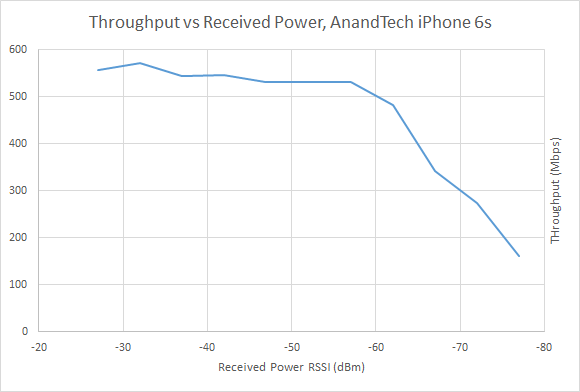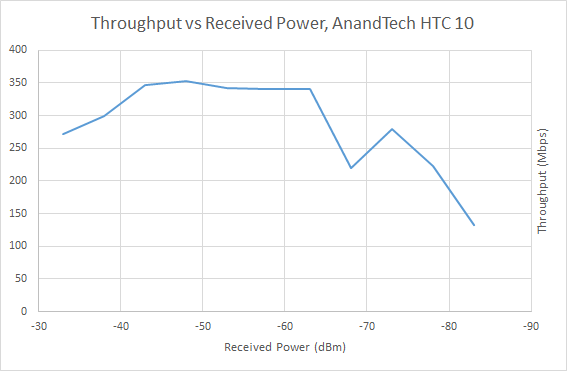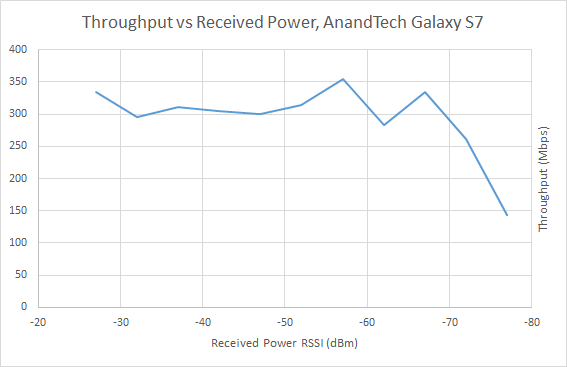The Samsung Galaxy S7 and S7 edge Review: Part 2
by Joshua Ho on July 5, 2016 8:00 AM ESTWiFi Testing with Ixia IoT
As previously discussed, RF testing has always been a major unknown to some extent because environmental factors make it extremely difficult to tell exactly what is going on with the system. I don’t think it really needs to be said but previous reviews and any controversy regarding the quality of RF has always lead to a ring of confusion and back and forth with no clear-cut answers, at least in the public domain. The Transformer Prime and Pixel C reception issues have all been cases where I’ve seen a lot of confusion over whether a problem really existed in the hardware, software, or with the end user.
Most people really don’t have any understanding of how wireless transmission works, probably because it’s not really something you can see. As far as I know, no one is capable of seeing radio waves, even at high frequencies like 60 GHz. Of course, the problem is that for quite some time our testing was also not really ideal for seeing the quality of an RF implementation. While iPerf does provide some useful data, free space testing means that we’re dealing with channel conditions that inherently cannot be controlled. As a result, the only sensible test we could do with iPerf was focus on maximum throughput in the best conditions we could provide. The only thing that this can highlight is the upper bound of efficiency for WiFi due to the carrier sense multiple access scheme in most cases, and rarely detects a whole class of problems that affect user experience on WiFi.
In order to test these things we’ve moved to using a proper testing system that is actually used by at least a few OEMs today, namely Ixia IoT. While we discussed the possibilities for testing, at this time due to the RF isolation chamber used we are limited to AP simulation only, so we can’t properly simulate clients in the channel without restricting ourselves to a single spatial stream for both the AP and client. This wouldn’t be a very useful test if set up in this manner as most devices today that we’re testing have support for two spatial streams, and many routers have three or even four spatial streams at this point.
The first set of results we can talk about that will be of interest is rate vs range. This is a fairly simple test at a conceptual level, as it simply tries to see how well a device can maintain its performance in the face of reducing signal to noise ratio for a given modulation and coding scheme. This is a good high level test of how well a device can maintain a connection as reception degrades. In this test the HTC 10 had an initial RSSI of -28 dBm while the GS7 was at -21 dBm and the iPhone 6s at -22 dBm, which allows us to calculate the path loss and determine the RSSI as a function of the transmit power.
The results of this test are interesting to say the least. Off the bat, every device had different RSSIs measured, so this meant that everything had different levels of path loss. The HTC 10 seemed to have the most path loss, while the Galaxy S7 and iPhone 6s were functionally identical. However it looks like RSSI is really an insufficient metric here because while the iPhone 6s was able to reach maximum throughput using NSS 2 MCS 8, the HTC 10 and Galaxy S7 did its best at NSS 2 MCS 4 or 5. I suspect this may be just due to placement as device positioning strongly affects MIMO as receive-side spatial correlation reduces the gains that MIMO can provide. Regardless, the HTC 10 somehow manages to beat the Galaxy S7 through much of the curve, but for some reason suffers from a reduction in throughput at higher transmit power. It's worth mentioning though that this test doesn't allow for testing of antenna gain or similar tests. Given various levels of futzing about with the device positioning in the test chamber I'm fairly confident that the Galaxy S7 is consistently better with regard to path loss, so even if it doesn't perform as well at a given RSSI it tends to have a higher RSSI than the HTC 10 by about 5 dBm which is fairly significant.
Finally, the other test that we can run at this time is the roaming latency test, which tests how well a device can hop from one access point to another as the received transmit power rises and falls. If you ever rely on WiFi to work as you walk around any building larger than a single apartment unit, you’re going to feel the effects of high roaming latency as VOIP calls or any real-time network application will either experience interruption or drop altogether if roaming is not implemented properly.

In the case of the Galaxy S7, roaming latency is honestly rather wanting. In the best case the Galaxy S7's roaming latency appears to be acceptable, but it's still significantly worse than the best we've seen so far. It seems that Samsung's algorithms have issues with edge cases as I've seen multiple instances so far where the device just can't handle roaming consistently. Despite consistent positioning and identical test setup I've seen cases where the Galaxy S7 has problems with consistent roaming. Even with the simple case of 10 dBm to -45 dBm at 3 dBm drop per second, I've encountered weirdness where the device drops from the network altogether claiming that the password given was incorrect (it wasn't) or a few successful handovers followed by getting stuck on a single access point or dropping from the network entirely. Even in the best set of trials performed I still saw 3 of 64 trials fail to roam correctly. The performance is certainly far better than something like the Google Pixel C, but Samsung should really be focusing on improving here.













266 Comments
View All Comments
lilmoe - Tuesday, July 5, 2016 - link
No...................... (wiping eyes)lilmoe - Tuesday, July 5, 2016 - link
OK, now that I've read the whole review (and some parts twice), I can come to two conclusions.1) The author is sort-of unhappy with Samsung's decision to dual source the SoC.
2) Lots of testing metrics (and data) don't match my personal experience with the phone (Edge, Exynos version), nor the hundreds of videos and reviews online. The only significant issue I have is with the front facing camera compared with other new hardware; it could be a LOT better (but I'm not a huge selfie person).
The Exynos variant is significantly better than the SD variant this time around, probably because Samsung's software leans more to higher core count, but also because it takes advantage of the *better* co-processors on Samsung's silicon. The Exynos variant has better image/video post processing, better audio, better and more sustained performance, better RAM management and significantly better battery life compared to the SD variant. Too bad all the hype Qualcomm has been selling for the additional parts didn't live up.
That being said, I do agree, to some extent, about the radios. They're definitely better than previous models (after the migration to metal design), but my wife's Note4 has noticeably better reception. Not huge, but noticeable. In that regard, nothing beats good ole' plastic designs.
cknobman - Tuesday, July 5, 2016 - link
The Apple bias you get from this site is annoying at best.Everything in this review is laced with a undertone of how iPhone is just as good or better.
Camera on the S7 is actually pretty danged amazing and easily better than what iPhone has right now. Other sites and reviews have posted their figures and results and they all show it but for some reason here the camera is just ok?
Battery life on the S7 is actually quite amazing and noticeably better than past Galaxy iterations.
The design is well executed and I did not see any mention of the water resistant feature which is a nice inclusion most other manufacturers dont even have.
I'm a Windows phone user but I did recently upgrade my son to the S7.
ikjadoon - Tuesday, July 5, 2016 - link
While Anandtech is getting better at moving away from esoteric benchmarks to show "in the lab" performance...these reviews were not holistic.How can you write a review comparing the iPhone 6s to the Galaxy S7 and NOT mention water resistance?
I think it's because, in the end, performance is what matters to Anandtech above all else. If the device doesn't perform well in day-to-day use, then whatever other benefits it may have are always painted against that background.
ikjadoon - Tuesday, July 5, 2016 - link
Why can't we edit? Yeesh. "Doesn't perform well compared to its equally-priced peers"...DERSS - Wednesday, July 6, 2016 - link
iPhone 6s/Plus already has water resistance, Apple covered the mainboard with special foam, and there are other measures. It is tested in videos, and it works. So the degree here is that SGS 7/Edge has better water resistance. The practical difference, though, is debatable.pablo906 - Friday, July 8, 2016 - link
I dropped my 6s in the sink full of water. Pulled it out shook it off, sucked the water out of the speaker holes, charging port holes, and headphone holes and it was fine. I've never had an iPhone survive that. They're not water proof, but their water resistance is certainly far better than it used to be and can survive day to day spills and accidents unlike the older models. That's nowhere near as good as the waterproof Samsung phones I've seen go underwater fully submerged for more than a few seconds in videos and come out alive, but it's an improvement. I agree with you here. If you want to compare water resistance among phones, then you have to take the non water resistant Android and get it wet measure the effects and then do the same with the Apple phones. I think that's a pointless road to go down. It's better to just mention the water proofing in the description or not at all and move on.theduckofdeath - Saturday, July 9, 2016 - link
I hope you don't live by that belief, DERSS. most mainboards has a protective coating, including the one in your PC. Mostly for dust and humidity protection. The ports, camera, sensors and most other things on the iPhone aren't water resistant. So... You might get lucky to survive getting it wet, but it most likely won't work properly after it.My previous (wireless) keyboard survived a glass full of Coke spilled all over it once. No issues, I just rinsed it off and let it dry off for a couple of days. Somehow I managed to spill another glass on in a month later (yay! I guess I subconsciously wanted a new keyboard) and it instantly fried.
theduckofdeath - Saturday, July 9, 2016 - link
*itBigbank - Tuesday, January 9, 2018 - link
BooGo get wet sinker